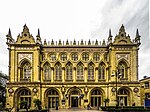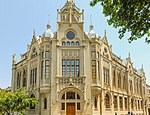Józef Płoszko
This article may require cleanup to meet Wikipedia's quality standards. The specific problem is: grammar. (January 2018) |
Józef Płoszko | |
|---|---|
 | |
| Born | 1867 |
| Died | 1931 |
| Nationality | |
| Known for | Architect |
Józef Płoszko (Polish: Józef Płoszko, Azerbaijani: Yuzef Ploşko, Russian: Иосиф Плошко; 1867—1931) was a Polish architect of the late 19th and early 20th centuries, author of multiple architectural projects in Baku, Azerbaijan.[1][2]
Biography
Józef Płoszko was born in 1867. He studied at the Russian Imperial Academy of Arts, but soon left it and joined the Petersburg University of Civil Engineers. After graduation in 1895, Plośko was sent to Kiev. Working there for two years, he moved to Baku at the invitation of another Polish architect Józef Goslawski and took place of local architect at construction department of the Baku city administration. He later became the chief architect of Baku.
Life in Baku
Plośko was close architect of millionaire Musa Naghiyev, but Murtuza Mukhtarov, Nuri Amiraslanov, the Rylskis - a rich Polish family and others also were among his clients. In 1907, Agha Musa Naghiyev purchased an area in the center of the city, on Nikolayevskaya (at present Istiglaliyyat Street) Street and ordered architect Plośko to build a public-charity building in memory of his earlier died son. The monumental Ismailiyya building built upon the pattern of the Doge’s palace in Venice was Plośko's first independent work in Baku. This building immediately became one of the main architectural sites of the city. Now it houses the Presidium of the National Academy of Sciences of Azerbaijan.[3]
After that, Plośko led construction of two private houses of Musa Naghiyev in the centre of Baku – residential houses on Telefonnaya (now 28 May Street) and Torgovaya Streets (now Nizami Street).[4] The architect received his second significant order - construction of mosque in Vladikavkaz city - from other famous millionaire – Murtuza Mukhtarov. Plośko familiarized himself with Islamic architecture on monuments of religious architecture in Baku. A temple finished in 1908 and called ‘Mukhtarov’s mosque” was built on the coast of the Terek River and is one of the most beautiful buildings of Vladikavkaz.
This mosque was followed by construction of other cultic works. Plośko restored Juma Mosque in Shamakhi and projected a Catholic Polish church (kostel) in Baku. Construction of the church couldn’t be completed because of the absence of great amount of material means, but the total size of the construction without flanking minarets and a central cupola (metallic carcass of the cupolas was ordered in Warsaw) – was finished. In 1918, during the Civil war, the mosque suffered significantly.
In 1909, Plośko worked out a project of the Catholic Church of Blessed Virgin Mary in Baku, the construction of which was finished in 1912.[5] The church was constructed by funds donated by Polish industrialists – the Rylskis and Witold Zglenicki, founder of petroleum production in the Caspian Sea. The church was constructed in gothic style, with usage of elements of Polish gothic style, which had a peculiar pompousness and richness of decorative forms, unlike the French and English styles. The building was located in a prestigious part of Baku – in crossing of Merkuryevskaya and Kaspiyskaya Streets (now Zarifa Aliyeva and Rashid Behbudov Streets). The church was demolished in 1930’s.
Construction of the “Palace of Happiness” in the center of Baku ordered by industrialist Murtuza Mukhtarov was the following work of Plośko. The building of the palace on Persidskaya Street (now Murtuza Mukhtarocv Street) stands before a viewer in the form of a central main tower part with facades, details of which are made in spirit of French gothic and with pompously decorated portal. The tower part is finished with a great figure of the Polish knight. At present, there is a palace of marriage in the building of the palace, which is considered one of the best constructions of that time.
A mansion of Kerbalayi Israfil Hajiyev on Shemakhinskaya Street (now Jabbarli Street) was built by Plośko, in 1910-1912’s. General composition is very dynamic and has features, intrinsic to vivid modern. After constructing multiple residential buildings in gothic and modern styles, Plośko directed to local architectural style. He constructed four-storeyed building in Baku – a house in national traditions on Politseyskaya Street (now Mammadaliyev Street) by the order of Rylski brothers. Classically symmetric vertical composition of façade with soft architectural forms, fine lines of platbands, stalactite cornice with merlons opens a new page in usage of national heritage. In 1919, the first Diplomatic Administration of Poland in Azerbaijan Democratic Republic was placed in this building led by Stefan Rylski.
A six-storeyed building of “New Europe” hotel, built by the order of Agha Musa Naghiyev on Qoncharovskaya Street (now Taghiyev Street), was the last work of Józef Plośko before the World War I. The hotel was equipped at the most modern level of that time – four elevators, sanitary appliances, central heating and concealed wiring. Reinforced concrete was broadly used as a load-bearing structure. As in all previous projects of Plośko, the façade of the building was faced with local limestone aglay.
Plośko also constructed the building of Baku Puppet Theatre, in 1908, which was initially used as cinema called "Phenomenon".[6]
The last years of his life
Plośko stayed in Baku after the October Revolution, worked as an engineer with Ziverbey Ahmadbeyov, another famous architecture of his time, participated in discussion of project of agglomerator cities of Baku in Absheron Peninsula. In 1925, after nearly thirty year living in Azerbaijan, he moved to Warsaw, and then to France.
Buildings constructed by Józef Plośko
| Construction date | Demolition date | Address | Owner | Annotations |
|---|---|---|---|---|
| 1908–1913 | - | Nikolayevskaya Street 10 | Musa Naghiyev | "Ismailiyya" (Muslim Charity Society/Presidium of the National Academy of Sciences of Azerbaijan) |
| 1908–1910 | - | Neftchiler Avenue | - | "Phenomenon" cinema/Baku Puppet Theatre |
| 1911–1912 | - | Polukhin Street 6 | Murtuza Mukhtarov | Mansion/The Palace of happiness |
| 1899–1900 | - | Balakhanskaya Street | 2-storeyed residential house | |
| 1899–1900 | - | Bolshaya Morskaya Street 65, corner of Pojarnaya lane | - | Building of fire brigade |
| - | - | Telefonnaya Street 4-6 | Agha Musa Naghiyev | Residential house |
| 1909-1914(?) | 1930(1931-?) | Corner of Kaspiyskaya and Merkuriyevskaya Streets | Catholic community | Catholic church of Blessed Virgin Mary |
| 1910 | - | Telefonnaya Street 10 | 4-storeyed residential house | |
| 1910 | - | Torgovaya Street 89 | - | 4-storeyed residential house |
| 1910 | - | Corner of Torgovaya and Gogol Streets | 4-storeyed residential house | |
| 1912 | - | Politseyskaya Street 11 | Rylski brothers | 4-storeyed residential house |
| 1900 | 2010 | Mammadaliyev Street | - | Residential house with atlantes |
| 1912 | - | Shemakhinskaya Street 12 | Kerbelayi Israfil Hajiyev | Mansion |
| 1913 | 1974 | Bayil district | 2-storeyed residential house | |
| - | - | Goncharovskaya Street 13 | Agha Musa Naghiyev | "New Europe" hotel/"Goy-Gol" |
| 1912 | - | Boulevard, near "Inturist" hotel | - | 3-storeyed apartment house |
| 1913 | - | Corner of Birjevaya and Krasnovodskaya Streets | 3-storeyed apartment house | |
| 1910 | - | Kaspiyskaya Street 25 | 3-storeyed apartment house | |
| 1910 | - | Mariinskaya Street 23 | 3-storeyed apartment house | |
| 1912 | - | Nikolayevskaya Street 21 | 3-storeyed apartment house | |
| 1900–1908 | Vladikavkaz | Murtuza Mukhtarov | Mukhtarov Mosque |
Gallery
- Buildings constructed by Józef Ploshko
-
Ismailiyya building in Baku
-
The "Palace of Happiness" in Baku
-
Naghiyev's house on 28 may street
-
Musa Naghiyev's house on Nizami Street
-
Mukhtarov's mosque in Vladikavkaz
-
The mansion of Kerbalayi Israfil Hajiyev on Shemakhinskaya Street (now Jabbarli Street)
-
4-storeyed residential house on 28 may Street
-
The six-storeyed building of “New Europe” hotel on Taghiyev Street
-
Catholic church of Blessed Virgin Mary in Baku
-
Building of Baku Puppet Theatre
References
- ^ "Архитекторы Баку".
- ^ "Архитектор Иосиф Плошко с супругой".
- ^ "Плошко Иосиф Касперович - архитектор". Наш Баку.
- ^ "Юзеф Плошко". Polonia Baku.
- ^ "Католицизм в Азербайджане". azeri.ru.
- ^ "Большая прогулка: чего вы не знали о Бакинском бульваре - РЕПОРТАЖ - ФОТО - ОПРОС". day.az.










